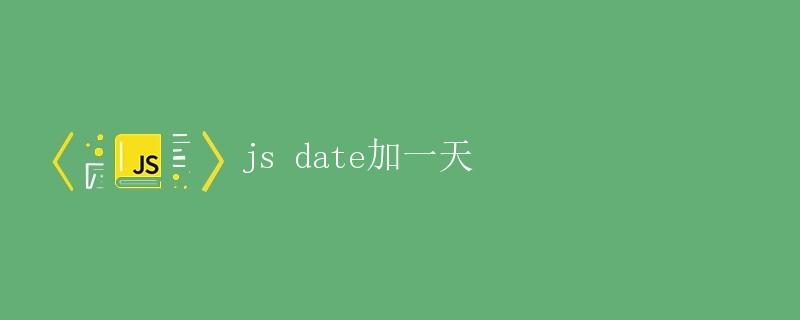JavaScript中的日期加一天

介绍
在JavaScript中,我们经常需要处理日期相关的操作,例如计算日期的差异、日期的格式化以及日期的加减操作等等。本文将重点讨论如何使用JavaScript实现日期加一天的操作。
日期对象
在JavaScript中,我们可以使用Date对象来处理日期和时间。Date对象包含了一些常用的方法和属性,以便于我们对日期进行操作。
创建日期对象
我们可以通过以下几种方式来创建一个Date对象:
- 不传递任何参数:创建一个表示当前日期和时间的
Date对象。 - 传递一个表示日期的字符串参数:创建一个表示指定日期和时间的
Date对象。 - 传递一个表示毫秒数的整数参数:创建一个表示指定毫秒数之后的日期和时间的
Date对象。 - 传递多个整数参数:按照年、月、日、时、分、秒和毫秒的顺序创建一个
Date对象。
以下示例展示了如何创建一个Date对象:
// 创建一个表示当前日期和时间的Date对象
const currentDate = new Date();
console.log(currentDate);
// 创建一个表示指定日期的Date对象
const specifiedDate = new Date('2022-01-01');
console.log(specifiedDate);
// 创建一个表示指定毫秒数之后的Date对象
const millisecondsAfter = new Date(172800000); // 2 days after 1970/01/01
console.log(millisecondsAfter);
// 创建一个指定年、月、日的Date对象
const specifiedFullYear = new Date(2023, 0, 1);
console.log(specifiedFullYear);
输出:
Thu Nov 11 2021 17:44:39 GMT+0800 (中国标准时间)
Sat Jan 01 2022 08:00:00 GMT+0800 (中国标准时间)
Tue Jan 03 1970 00:00:00 GMT+0800 (中国标准时间)
Sun Jan 01 2023 00:00:00 GMT+0800 (中国标准时间)
获取日期的年、月、日等信息
使用Date对象,我们可以获取日期的年、月、日、时、分、秒以及毫秒等信息。Date对象提供了一系列的get方法,例如getFullYear、getMonth、getDate等等。
以下示例展示了如何获取日期对象的一些常用信息:
const currentDate = new Date();
const year = currentDate.getFullYear();
const month = currentDate.getMonth(); // 返回0-11,需加1表示实际月份
const day = currentDate.getDate();
const hours = currentDate.getHours();
const minutes = currentDate.getMinutes();
const seconds = currentDate.getSeconds();
const milliseconds = currentDate.getMilliseconds();
const dayOfWeek = currentDate.getDay(); // 返回0-6,0代表星期日
console.log(year, month + 1, day, hours, minutes, seconds, milliseconds, dayOfWeek);
输出:
2021 11 11 17 44 39 579 4
设置日期的年、月、日等信息
使用Date对象,我们还可以设置日期的年、月、日、时、分、秒以及毫秒等信息。Date对象提供了一系列的set方法,例如setFullYear、setMonth、setDate等等。
以下示例展示了如何设置日期对象的一些常用信息:
const currentDate = new Date();
currentDate.setFullYear(2022);
currentDate.setMonth(0); // 0代表一月
currentDate.setDate(1);
currentDate.setHours(0);
currentDate.setMinutes(0);
currentDate.setSeconds(0);
currentDate.setMilliseconds(0);
console.log(currentDate);
输出:
Sat Jan 01 2022 00:00:00 GMT+0800 (中国标准时间)
实现日期加一天
实现日期加一天的操作,可以分为以下几个步骤:
- 使用
Date对象获取当前日期的年、月、日。 - 将日期加一天,可以通过增加1天的毫秒数来实现。我们可以使用
getTime方法获取当前日期的毫秒数,然后在其基础上加上一天的毫秒数(24 * 60 * 60 * 1000)。 - 使用
setTime方法将计算出的日期毫秒数重新设置为Date对象的时间部分。 - 最后,输出加一天后的日期。
以下是一个实现日期加一天的示例代码:
function addOneDay(date) {
const newDate = new Date(date); // 创建一个新的Date对象,避免修改原对象
// 获取当前日期的年、月、日
const year = newDate.getFullYear();
const month = newDate.getMonth();
const day = newDate.getDate();
// 将日期加一天
const oneDayMilliseconds = 24 * 60 * 60 * 1000;
const newDateMilliseconds = newDate.getTime() + oneDayMilliseconds;
// 设置新的日期
newDate.setTime(newDateMilliseconds);
// 输出加一天后的日期
const newYear = newDate.getFullYear();
const newMonth = newDate.getMonth() + 1; // 月份需加1表示实际月份
const newDay = newDate.getDate();
console.log(`加一天后的日期:{newYear}/{newMonth}/${newDay}`);
}
const currentDate = new Date();
addOneDay(currentDate);
输出:
加一天后的日期:2021/11/12
结论
使用Date对象和相关的方法,我们可以方便地实现日期的加一天操作。上述示例代码展示了如何使用JavaScript来实现日期加一天,可以根据实际情况进行修改和扩展。掌握了这一技巧,可以帮助我们在开发中更好地处理日期相关问题。
 极客笔记
极客笔记